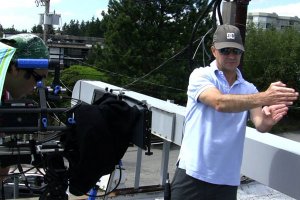As the crew gets the lay of the land in Salvador, Brazil to film our first 3D documentary, two stories about the mission have been freshly pressed here in Canada:
Film production firm Parallax forwards 3-D vision
The Vancouver Sun’s Marke Andrews spoke to me about our 3D vision, and the challenges of getting stereoscopic material from capture to broadcast.

President Ian Herring and stereographer Sean White (left) test custom-made equipment that will be used to shoot Parallax Film Production’s first 3D documentary
Quotable quote:
“So when I contact Ian Herring, founder and president of Parallax Film, the obvious question is: Given that it will cost as much as 50-per-cent more to make the show in 3-D, why bother?
‘It’s a bit of a cart before the horse, I guess. But this is a creative industry with vision, and if somebody doesn’t do something visionary, we’re never going to advance,’ says Herring.”
Read the full Vancouver Sun article here.
Documentary director experiments with custom cameras as TV filming moves into a new dimension
Mike Reid, reporter for Victoria’s Times Colonist, also interviewed stereographer Sean White, focusing on what it’s going to take to master this 3D crash course in the field, shooting the implosion of the Fonte Nova Stadium for the explosive demolition series Blowdown:

Stereographer Sean White hones two Canon 7Ds on a side by side rig – gear that will be used to shoot elements of Parallax Film Production’s first 3D documentary
Quotable quote:
“Their first challenge was finding the ideal 3-D camera to capture such footage for TV.
‘What do we use? Oh, let’s just use the 3-D camera that doesn’t exist,’ recalled White, laughing. ‘It’s a major investment on Parallax’s part to be so pioneering and at the forefront of this technology.’
White and his collaborators at the firm, which specializes in production of science and history programs for Canadian and international broadcast, have spent a long time researching and developing ‘stereoscopic’ systems to pull it off.
During the event, 40 cameras — each a customized system — will roll simultaneously.”
Read the full Times Colonist article here.



